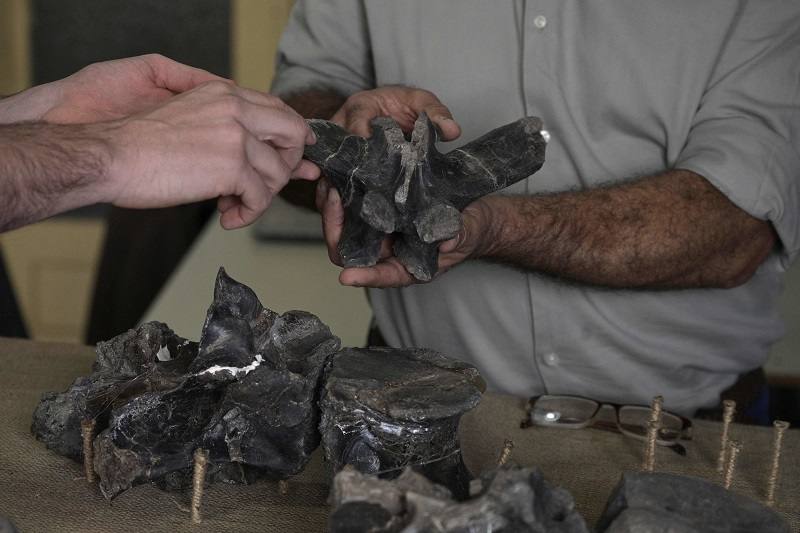
Paleontologists check fossilized bones of Maip macrothorax, at the Bernardino Rivadavia Argentine Museum of Natural Science, in Buenos Aires on May 2.
7:20 JST, May 18, 2022
BUENOS AIRES (AFP-Jiji) — Argentine paleontologists have announced the discovery of an apex-predator dinosaur that measured three stories from nose to tail and eviscerated its prey with sharp, curved claws.
The six-ton giant, the largest megaraptor unearthed to date, fed on smaller dinosaurs that it ripped to shreds with its talons before digging into their intestines, paleontologist Mauro Aranciaga told AFP.
It would have been the “apex predator” of its time, said Aranciaga — well deserving of its chilling scientific name “Maip macrothorax.”
The first part, “Maip,” is derived from an “evil” mythological figure of Patagonia’s indigenous Aonikenk people.
The character was associated with “the shadow of the death” that “kills with cold wind” in the Andes mountains, according to a study reporting the find in the Nature journal Scientific Reports.
The second part, “macrothorax,” refers to the enormous expanse of the creature’s chest cavity — some 1.2 meters wide.
The newly-identified monster measured nine to 10 meters in length, larger than any previously discovered type of megaraptor — a group of flesh-eating giants that once roamed what is now South America, according to Aranciaga’s team.
It lived about 70 million years ago toward the end of the Cretaceous period in what was then a tropical forest, long before the Andes mountain range and glaciers that now define Patagonia.
The killer reptile had two sharp, curved claws per front paw, each talon some 40 centimeters long.
Aranciaga, now 29, had the good fortune of finding the first piece of Maip on his first-ever professional expedition three years ago to Argentina’s Santa Cruz Province.
This led to months of meticulous digging, cleaning and classification of a large cache of bones: vertebrae as well as bits of rib, hip, tail and arm.
“When I lifted the vertebra and saw that it had the characteristics of a megaraptor, it was really a huge thrill,” recalled Aranciaga.
"World" POPULAR ARTICLE
-

8 Japanese Nationals Stranded on Indonesia’s Sumatra Island
-

Mozambican Cooking Class Held in Matsuyama, Ehime Pref.; Participants Don Aprons, Bandanas Made from Traditional Mozambique Fabric
-

U.S. Senate Resolution Backs Japan, Condemns China’s Pressure
-

China to Impose Sanctions on Shigeru Iwasaki, Former Head of Japan’s Self-Defense Forces, Who Serves as Adviser to Taiwan’s Executive Branch
-

South Korea’s Top Court Dismisses Nippon Steel Appeal in Lawsuit over Requisitioned Worker
JN ACCESS RANKING
-

Tokyo Economic Security Forum to Hold Inaugural Meeting Amid Tense Global Environment
-

Keidanren Chairman Yoshinobu Tsutsui Visits Kashiwazaki-Kariwa Nuclear Power Plant; Inspects New Emergency Safety System
-

Imports of Rare Earths from China Facing Delays, May Be Caused by Deterioration of Japan-China Relations
-

University of Tokyo Professor Discusses Japanese Economic Security in Interview Ahead of Forum
-

Japan Pulls out of Vietnam Nuclear Project, Complicating Hanoi’s Power Plans






















